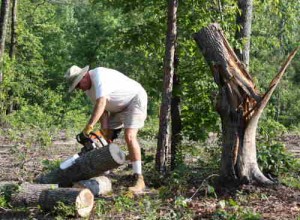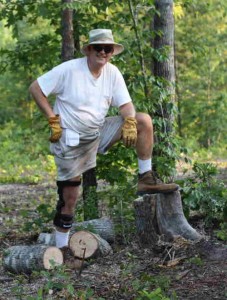I love cutting and splitting firewood. Even though I generally dislike tasks I must wear ear protection to perform, I make an exception for firewood. It’s uniquely satisfying to watch a stack build up on one of our pallets and know that it will keep us warm in the winter we know will arrive one day. The part I hate is stumps.
We rarely have to fell a tree, because we have such a good supply of deadfall in our forest. More often, we’ll come upon a tree that’s already fallen in the woods, and we will decide to cut it up. So most of the cuts are straight down, which frees me up to dig the spike bumper of my chain saw into the trunk of the tree and let gravity pull the bar down to make the cut.
As I work my way through the cut, I just periodically reposition the spike bumper as I continue. I can position myself above the cut and see clearly the progress I’m making. I can position the tree over a piece I’ve already cut so that the kerf opens and keeps the chain free. With a sharp chain, I can make fairly short work of everything but a petrified hickory.
I have recently begun producing more uniform lengths of wood. Right now I measure the length of every cut; my optimal length is exactly the distance between the tip of the spike bumper and the tip of the chain, approximately 17 inches. Eventually, I may get so accustomed to the length we need that I don’t have to measure.
But whenever I have finished cutting the lengths of firewood and I’m ready to get Amanda’s help to split and stack the wood on the pallet, I have learned to gird my loins because I know it’s coming: “Aren’t you going to cut it down shorter?” What she means, of course, is that I’m leaving an unsightly stump that she finds unacceptable.
So generally I try to cut it off closer to the ground. And when I do, all those advantages I told you about above evaporate. Suddenly gravity’s not there to help me. It’s much harder to get the spike bumper to bite, and I can’t see the cut clearly. And as I cut, if there’s any weight to the stump it begins to settle onto the kerf and bind my chain. I’m reduced to a frustrated shell of my former lumberjack self, cuttin’ and cussin’, cuttin’ and cussin’. Cutting stumps is a thoroughly miserable experience, made all the more miserable because it takes so long. If it takes me 30 minutes to cut a tree into firewood lengths so we can split and stack it for firewood, it will take 45 minutes to take down that cursed stump.
 This weekend the problem became especially aggravating, for two reasons. First, the tree was a sweetgum, which is nothing to write home about as firewood, so I didn’t want to spend too much time with it. And the tree wasn’t all that big to begin with. It came down in the recent storm that swept through central Alabama and dumped 10 inches of rain in just a few hours. The meteorologists label it a “100-year event.” Amanda and I suspect, by the way, that the next several decades will bring an assault of unprecedented weather events, each one seemingly unrelated to others, but in fact all exacerbated by catastrophic climate change.
This weekend the problem became especially aggravating, for two reasons. First, the tree was a sweetgum, which is nothing to write home about as firewood, so I didn’t want to spend too much time with it. And the tree wasn’t all that big to begin with. It came down in the recent storm that swept through central Alabama and dumped 10 inches of rain in just a few hours. The meteorologists label it a “100-year event.” Amanda and I suspect, by the way, that the next several decades will bring an assault of unprecedented weather events, each one seemingly unrelated to others, but in fact all exacerbated by catastrophic climate change.
This tree was one of 25 or so that came down in the storm, but it got our attention because it was right out in the middle of Veg Hill. Because it was small, it should have been manageable. Amanda took the shot on the left as I was making one of the last cuts, feeling my oats with my quick progress.
Then I started working on that stump. As you can see, it was bent and torn as it fell, and it was difficult to find a decent cutting angle. I started by trying to cut off some of the top just to manage the weight, but my saw kept binding up. I then started working down below. Cutting about a foot off the ground, I laboriously whittled away at the kerf. The binding set in almost immediately because of the unusual weight of the trunk above. And if you’ve ever cut a sweetgum, you know there’s a ton of moisture in it. All that moisture seemed to settle in on the cut and make the binding worse.
After 30 or 40 minutes of demotivating whittling, I fetched a chain and a come-along, hoping I could hitch it to a nearby American beech and put enough sideways tension on the stump to keep the kerf open. Didn’t help a bit.
 Then Amanda suggested I try pushing it with Tractor. I didn’t think it would do any good, but for the first time the trunk began to give way. I pushed a while and cut a while and pushed a while and cut a while for another 15 minutes or so. No, that’s not the right way to say it. Let’s be honest: I sat in the driver’s seat of a 55-hp tractor and let it use petroleum to push a while, and then I cranked up a gasoline-powered chain saw and let it use petroleum to cut a while. Makes you wonder, doesn’t it, how fast that silly stump would have come down without all that power?
Then Amanda suggested I try pushing it with Tractor. I didn’t think it would do any good, but for the first time the trunk began to give way. I pushed a while and cut a while and pushed a while and cut a while for another 15 minutes or so. No, that’s not the right way to say it. Let’s be honest: I sat in the driver’s seat of a 55-hp tractor and let it use petroleum to push a while, and then I cranked up a gasoline-powered chain saw and let it use petroleum to cut a while. Makes you wonder, doesn’t it, how fast that silly stump would have come down without all that power?
Eventually, Tractor pushed it over far enough that I could cut off the remaining remnant, pick up the bent portion, and pile it up for burning. Yes, we still have a stump out on Veg Hill, but I think Amanda didn’t have the heart to complain that we are leaving it; she knew how hard we had worked to get to this point.
That sweetgum now forms the better part of pallet #8, rounding out our second full cord. Come on winter; we’re ready for you.